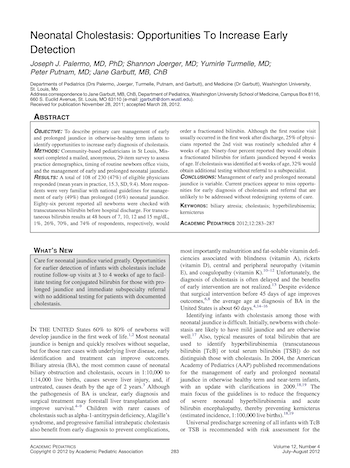Neonatal Jaundice
2009-2010
Neonatal cholestasis: opportunities to increase early detection
July 1, 2012
Palermo JJ, Joerger S, Turmelle Y, Putnam P, Garbutt J. Neonatal cholestasis: opportunities to increase early detection. Acad Pediatr. 2012 Jul-Aug;12(4):283-7. doi: 10.1016/j.acap.2012.03.021. Epub 2012 May 26. PMID: 22634076; PMCID: PMC3398230.
Objective
To describe primary care management of early and prolonged jaundice in otherwise-healthy term infants to identify opportunities to increase early diagnosis of cholestasis.
Methods
Community-based pediatricians in St Louis, Missouri completed a mailed, anonymous, 29-item survey to assess practice demographics, timing of routine newborn office visits, and the management of early and prolonged neonatal jaundice.
Results
A total of 108 of 230 (47%) of eligible physicians responded (mean years in practice, 15.3, SD, 9.4). More respondents were very familiar with national guidelines for management of early (49%) than prolonged (16%) neonatal jaundice. Eighty-six percent reported all newborns were checked with transcutaneous bilirubin before hospital discharge. For transcutaneous bilirubin results at 48 hours of 7, 10, 12 and 15 mg/dL, 1%, 26%, 70%, and 74% of respondents, respectively, would order a fractionated bilirubin. Although the first routine visit usually occurred in the first week after discharge, 25% of physicians reported the 2nd visit was routinely scheduled after 4 weeks of age. Ninety-four percent reported they would obtain a fractionated bilirubin for infants jaundiced beyond 4 weeks of age. If cholestasis was identified at 6 weeks of age, 32% would obtain additional testing without referral to a subspecialist.
Conclusions
Management of early and prolonged neonatal jaundice is variable. Current practices appear to miss opportunities for early diagnosis of cholestasis and referral that are unlikely to be addressed without redesigning systems of care.
